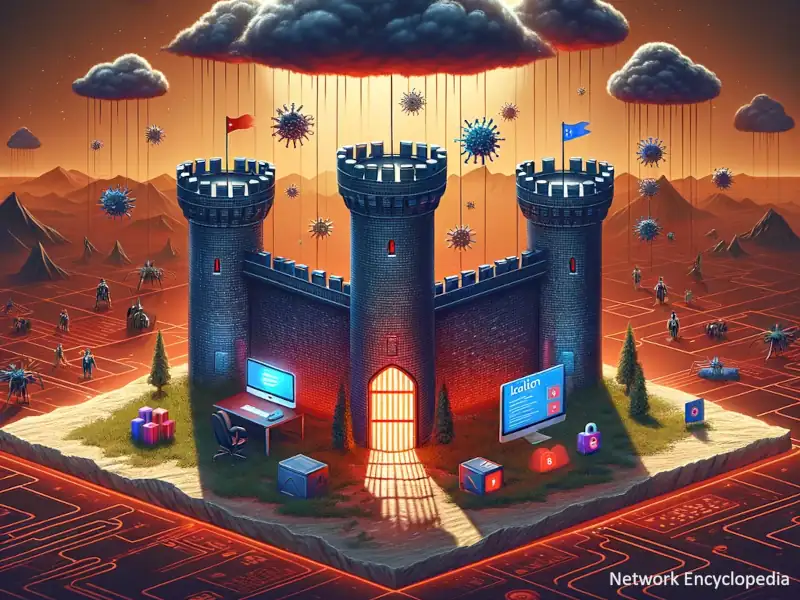In the ever-evolving landscape of computer science, the concept of a “sandbox” is akin to a gated playground found in a park, but instead of swings and slides, this one’s outfitted with code, applications, and virtual processes.
In this article, we’ll delve into the intriguing world of sandboxes, exploring their purpose, mechanics, and the pivotal role they play in technology. Just as children experiment and learn within the safe confines of a playground sandbox, developers and programmers use digital sandboxes to test and refine their creations without risking the larger digital environment. Buckle up as we dig deep into the sandbox—where the only limit is one’s programming prowess!

Table of Contents
- What is a Sandbox?
- Why Use a Sandbox?
- Types of Sandboxes
- How Sandboxes Work
- Sandboxing in Different Technologies
- The Impact of Sandboxing on Security
- Future of Sandboxing
- References
1. What is a Sandbox?
1.1. The Basic Concept
Imagine if you could press a magic button that would allow you to test your wildest inventions with no repercussions. Mess up? No problem. Just reset and start over. This is essentially the spirit behind a “sandbox” in the world of computing. A sandbox is a controlled environment where programs, code, or apps can run safely, without affecting other parts of the system. If something goes awry, it’s all contained within this isolated play area.
1.2. Sandbox vs. Real World: Boundaries and Freedom
To understand a sandbox, picture a child’s sandbox in the middle of a bustling park. Within the wooden borders of the sandbox, the rules of the outside world don’t apply. Here, children can build castles, dig to their heart’s content, or even sculpt a miniature grand canyon—all without affecting the grass and paths only a footstep away. Similarly, in computing, a sandbox lets developers play with risky code or test an app with zero risks to the operating environment. It offers a perfect balance—rigorous enough to implement real-world scenarios, yet flexible and secure to encourage fearless experimentation.

In our next section, we’ll explore why exactly sandboxes are so crucial in the tech industry—not just for safety, but as crucibles of innovation. Stay tuned to see how these digital playgrounds are more than just safety nets; they are launchpads for creativity and progress.
2. Why Use a Sandbox?
2.1. Safety First: Containing the Mess
The primary allure of the sandbox is its ability to contain chaos. Just like a physical sandbox prevents sand from scattering across the playground, a digital sandbox contains potentially disruptive code within its confines. This controlled environment protects the rest of the system from unintended consequences such as bugs, security vulnerabilities, or system crashes that could arise from untested software. For instance, when a developer wants to try out a new, unproven algorithm that might destabilize the existing system, they can unleash it in the sandbox where the stakes are low and the clean-up is easy.

It’s like having a test kitchen in a restaurant where new recipes are tried away from the main kitchen, ensuring that a culinary disaster doesn’t end up on a customer’s plate.
2.2. Experimentation and Innovation
Sandboxes not only prevent disaster but actively promote creativity and innovation. They provide a safe haven where developers can experiment with new programming languages, update existing software, and develop complex features without the risk of affecting active users or critical systems. This freedom allows developers to push boundaries and explore possibilities that would be too risky to attempt in a live environment. Think of it as a science lab for computer programs where every experiment adds value, whether it succeeds or leads back to the drawing board.
2.3. Examples in Software Development
Real-world applications of sandboxes in software development are plentiful and varied. For example, major web browsers like Chrome and Firefox use sandboxes to test new features and security updates before they reach the general public. Similarly, video game developers use sandboxes to tweak game mechanics and test new levels without affecting the gameplay experience for current players. Even large-scale software as a service (SaaS) platforms like Salesforce provide sandbox environments that allow enterprise developers to customize and test software changes in a replica of their live environment, ensuring that any modification fits perfectly before going live.
3. Types of Sandboxes
3.1. Development Sandboxes
Development sandboxes serve as the initial stage for new software projects. They are typically used by individual developers or small teams to build and shape the first versions of new applications or features. These sandboxes are like sketchbooks for artists—spaces where ideas can be freely explored and iterated upon before any formal assessment or testing. The key advantage of a development sandbox is that it supports rapid prototyping and iteration, crucial for agile development environments where speed and adaptability are paramount.
3.2. Testing Sandboxes
Once a product or feature exits the development phase, it enters the testing sandbox. This is where things get serious: the code is no longer just a concept but is being groomed for production. Testing sandboxes are used to conduct thorough testing including integration testing, performance testing, and user acceptance testing. This ensures that the product is not only functional but also user-friendly and robust under various conditions. It’s similar to putting a prototype car through crash tests and performance assessments to ensure it’s roadworthy.
3.3. Production Sandboxes
The final frontier for sandboxing is the production sandbox, which is used as a final staging area before the software goes live. This type of sandbox is designed to mirror the live environment as closely as possible, providing a final check to catch any issues that might not have been evident in earlier tests. Think of it as the dress rehearsal before opening night of a Broadway show. It’s the last chance to make sure every line, lighting cue, and scene transition is just right before the curtain rises.
Each type of sandbox plays a critical role in the lifecycle of software development, offering specific tools and environments tailored to the needs of development teams at every stage from conception to delivery.
» To read next: Ethics in Machine Learning!
4. How Sandboxes Work
4.1. The Technical Foundations
At its core, the technology behind a sandbox revolves around creating a separate, secure environment within a larger system where software, programs, or code can run in isolation. This is achieved through a combination of hardware and software mechanisms that enforce a strict boundary between the sandbox and the host environment. The mechanisms are designed to be robust enough to prevent any code within the sandbox from “escaping” or influencing the broader system. It’s similar to how a magician uses a combination of physical barriers and optical illusions to ensure that the audience sees only what is intended, keeping the secrets contained and controlled.
4.2. Creating a Virtual Environment
Creating a virtual environment, or a sandbox, involves allocating a subset of system resources—like memory, processing power, and network access—to a specific application or process while strictly controlling their interaction with the rest of the system. This can be likened to building a miniature, self-contained version of a computer within a computer. Virtualization technologies such as VMWare, Docker, and Kubernetes play crucial roles here, each acting as a type of virtual sandbox, providing developers the tools to replicate full systems or isolated testing environments seamlessly.
4.3. Isolation Techniques
Isolation is the linchpin of effective sandboxing. Various techniques are used to achieve this, including namespace isolation, which limits an application’s visibility to parts of the system; resource limits, which cap how much CPU or memory an application can use; and strict I/O controls, which monitor and filter input and output data to and from the sandbox. These methods ensure that even if malicious code is executed within the sandbox, its effects are contained and cannot interfere with the host environment.

It’s like having watertight compartments in a ship; if one floods, the others remain dry and secure, preserving the vessel’s integrity.
» To read next: The 2016 Dyn Cyberattack: An Overview.
5. Sandboxing in Different Technologies
5.1. Web Browsers
Web browsers are perhaps the most familiar playgrounds for sandboxing technology. Modern browsers like Google Chrome and Mozilla Firefox use sandboxes to segregate different tabs and plugins from each other, thus enhancing security. When a website is opened, it’s confined within its tab—like a lion in a cage—preventing it from accessing data from another tab (say, your online banking) or from the underlying operating system. This is critical for preventing attacks such as cross-site scripting or malicious file downloads that could otherwise wreak havoc on a user’s system.
5.2. Operating Systems
Operating systems like Windows, macOS, and Linux have also adopted sandboxing techniques, particularly for running suspicious applications or for developers testing software. macOS, for example, utilizes a feature called App Sandbox, which restricts the resources apps can access and what they can do on a device. This ensures that even if an application turns out to be malicious, its potential for damage is minimized. It’s like giving someone a map of a minefield; they can navigate safely without stepping on a mine.
5.3. Mobile Applications
In the realm of mobile applications, both Android and iOS use sandboxing extensively to manage apps and protect user data. Each app is run in its isolated environment, unable to access data from other apps unless explicitly permitted by the user or system. This not only helps in maintaining operational stability by preventing apps from interfering with each other but also secures personal data from being accessed by every app installed on the device. This system is akin to living in an apartment block where each tenant has a key only to their apartment and cannot access the others without explicit permission.
Through these various implementations, sandboxing remains a fundamental aspect of modern computing across technologies, safeguarding systems by keeping potential threats well-contained and under strict surveillance. It’s a testament to the ingenuity of digital architects who’ve designed these impenetrable virtual fortresses to ensure that the digital world remains a safe playground for all.
6. The Impact of Sandboxing on Security
6.1. Enhancing Security Protocols
Sandboxing has fundamentally changed the security landscape by adding a robust layer of protection against malicious software and attacks. By isolating potentially harmful code, sandboxes prevent it from accessing critical system resources and data. This isolation is pivotal for security testing, where unknown or untrusted software can be executed without risk to the main system. Moreover, sandboxes enhance overall security protocols by allowing for the safe study and analysis of malware behavior, which in turn leads to improved antivirus and anti-malware products.

The incorporation of sandboxing in threat detection systems has become akin to having a controlled lab environment where dangerous viruses can be studied safely without posing a risk to the public.
6.2. Limitations and Vulnerabilities
Despite their effectiveness, sandboxes are not foolproof and have inherent limitations and vulnerabilities. For instance, sophisticated malware can detect when it is being run in a sandbox and alter its behavior to evade detection, a tactic similar to a chameleon changing its colors to blend into its surroundings. Additionally, the very isolation that makes sandboxes effective can also be a drawback, as it may prevent the full interaction of code with the system, potentially missing out on detecting some behaviors that would manifest only in a less restricted environment. Finally, maintaining and updating sandbox environments to keep up with the latest security threats can be resource-intensive.
7. Future of Sandboxing
7.1. Trends and Predictions
The future of sandboxing is likely to be influenced by the increasing sophistication of cyber threats and the continuous evolution of technology. One trend is the integration of sandboxing with artificial intelligence (AI) to create smarter, adaptive sandbox environments that can detect and respond to malware tactics dynamically. Additionally, as cloud computing continues to grow, cloud-based sandboxes are becoming more prevalent, providing scalable and flexible solutions for security testing and data analysis on a massive scale.
7.2. Innovations on the Horizon
Looking ahead, we can anticipate several innovations in sandbox technology. One such innovation is the development of decentralized sandboxing, where distributed systems can run and test code in multiple, interconnected sandboxes, greatly enhancing both the scalability and the robustness of security measures. Another exciting prospect is the use of quantum computing principles to develop sandboxes that could potentially simulate and counter quantum-level threats, ensuring security in a post-quantum world.
8. References
8.1. Books
- “Operating System Security” by Trent Jaeger
- “Ask Your Developer – How to Harness the Power of Software Developers and Win in the 21st Century“, by Jeff Lawson, February 2021.
8.3. Academic Papers and Articles
- “Unveiling the Dynamic Landscape of Malware Sandboxing: A Comprehensive Review“, by Elhaam Debas, Norah Alhumam, Khaled Riad – ResearchGate (September 2020).
- “Sandbox: A Secured Testing Framework for Applications“, by Sr Swamy –
- “Does Sandboxing Have A Future?“, by Etay Maor – Forbes, Mar 2022.
- “Fundamentals of Sandboxing“, Baeldung, March 2024.